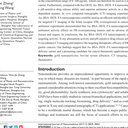Protein tyrosine phosphatase inhibition reduces degeneration of dopaminergic substantia nigra neurons and projections in 6-OHDA treated adult rats.
キーワード
概要
The survival of injured adult dopaminergic substantia nigra pars compacta neurons can be promoted by various neurotrophic factors. Most neurotrophic factor receptors are activated by intracellular tyrosine phosphorylation upon ligand binding and are subsequently inactivated or dephosphorylated by protein tyrosine phosphatases. This raised the possibility that tyrosine phosphatase inhibition might improve neuronal survival. Here, we infused the stable water-soluble tyrosine phosphatase-specific inhibitor, peroxovanadium [potassium bisperoxo(1,10-phenanthroline)oxovanadate (V) (bpV(phen))], for 14 days close to the substantia nigra starting immediately after a unilateral moderate injury by injection of the neurotoxin 6-hydroxydopamine (6-OHDA) into the midbrain of adult Sprague-Dawley rats. The dopaminergic nigrostriatal neurons were identified by retrograde tracing with fluorogold 7 days prior to the injury. With infusion of 3 or 10 microm peroxovanadium, 75% of these neurons survived compared to 45% in vehicle-infused rats. Degeneration of the dopaminergic projections to the neostriatum was also reduced by 10 microm peroxovanadium. Twenty minutes after an acute injection of peroxovanadium into the substantia nigra, increased tyrosine phosphorylation in Western blots of nigral extracts was seen in the same protein bands as after injections of brain-derived neurotrophic factor (BDNF) or NT-4. This suggests that peroxovanadium enhances endogenous neurotrophic signalling resulting in improved neuronal survival. The neuroprotective effects of this small molecule protein tyrosine phosphatase inhibitor represent a proof-of-principle for a novel treatment strategy in a model for Parkinson's disease.


